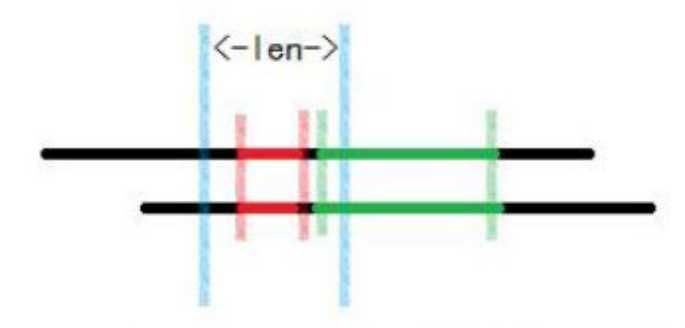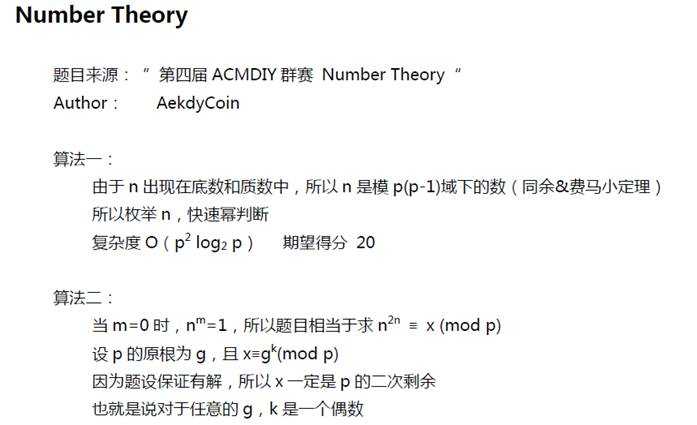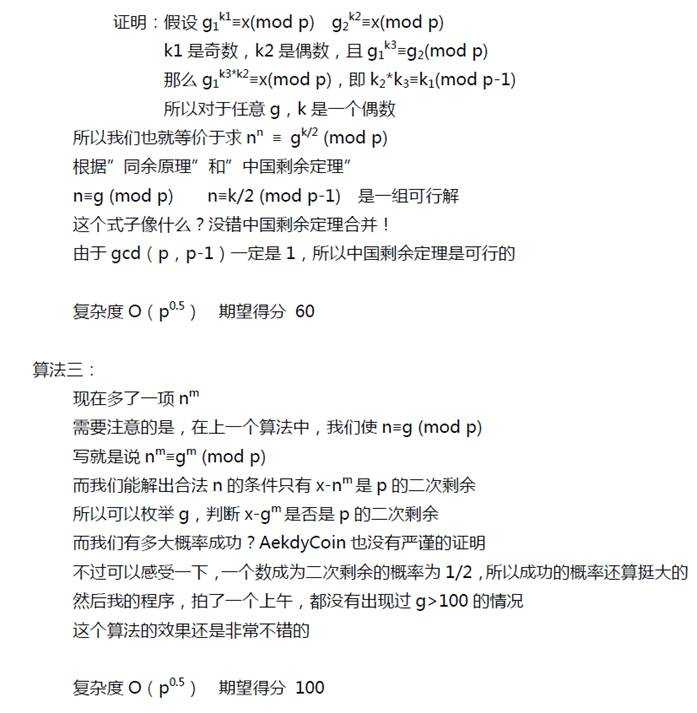0+0+0=0。还是太菜,看不出题型。
你要从 (0,0) 点走到 (n,m),每次只能往 x 轴或者 y 轴正方向移动一个单位距离。从 (i,j) 移动到 (i,j+1) 的代价为 ri,从 (i,j) 移动到 (i+1,j) 的代价为 cj。
求最小代价。
对于 100%的数据,n,m ≤ 105。
凸包的运用……我看不出来还算正常。
考虑从 \((x_1,y_1)\) 走到 \((x_2,y_2)\),只能先走行再走列或者先走列再走行。
先走行再走列,代价为
\[
r_{x_1}(y_2-y_1)+c_{y_2}(x_2-x_1)
\]
先走列再走行,代价为
\[
c_{y_1}(x_2-x_1)+r_{x_2}(y_2-y_1)
\]
对这两种走法进行套路化比较
\[
r_{x_1}(y_2-y_1)+c_{y_2}(x_2-x_1)<c_{y_1}(x_2-x_1)+r_{x_2}(y_2-y_1)\\Rightarrow~\frac{r_{x_2}-r_{x_1}}{x_2-x_1}>\frac{c_{y_2}-c_{y_1}}{y_2-y_1}
\]
所以对行列分别维护凸包,双指针扫描,每次走斜率大的。
时间复杂度 \(O(n+m)\)。
#include<bits/stdc++.h>
using namespace std;
template<class T> T read(){
T x=0,w=1;char c=getchar();
for(;!isdigit(c);c=getchar())if(c=='-') w=-w;
for(;isdigit(c);c=getchar()) x=x*10+c-'0';
return x*w;
}
template<class T> T read(T&x){
return x=read<T>();
}
#define co const
#define il inline
typedef long long LL;
co int N=100000+10;
int r[N],c[N];
int sr[N],tr,sc[N],tc;
void convex(int a[],int st[],int&top,int n){
for(int i=0;i<=n;++i){
while(top>=2&& (LL)(a[i]-a[st[top]])*(st[top]-st[top-1])<=(LL)(a[st[top]]-a[st[top-1]])*(i-st[top]) ) --top;
st[++top]=i;
}
}
int main(){
freopen("masodik.in","r",stdin),freopen("masodik.out","w",stdout);
int n=read<int>(),m=read<int>();
for(int i=0;i<=n;++i) read(r[i]);
for(int i=0;i<=m;++i) read(c[i]);
convex(r,sr,tr,n),convex(c,sc,tc,m);
LL ans=0;
int i=1,j=1;
while(i<tr&&j<tc){
if( (LL)(r[sr[i+1]]-r[sr[i]])*(sc[j+1]-sc[j])>=(LL)(c[sc[j+1]]-c[sc[j]])*(sr[i+1]-sr[i]) )
ans+=(LL)r[sr[i]]*(sc[j+1]-sc[j]),++j;
else ans+=(LL)c[sc[j]]*(sr[i+1]-sr[i]),++i;
}
if(i==tr) ans+=(LL)r[n]*(m-sc[j]);
else ans+=(LL)c[m]*(n-sr[i]);
printf("%lld\n",ans);
return 0;
}给定一个长度为 n 的数列 P,满足 |Pi| ≤ 109
求有多少对 (a,b,c,d),满足下列约束:
只要 (a,b,c,d) 中有任意一个参数不同,我们就认为是不同的。
n ≤ 105
被题目名字骗了,我竟然没有看出来这是字符串匹配……我该更新自己对字符集的认识。
枚举两段的长度 len 和第一段的起点 i,我们定义 L 为第一段与第二段的最长公共后缀,当 L>=len 的时候答案+1,而起点为 i+1 时 L 的大小仅仅取决于起点为 i 时 L 大小和 a[i+len] 与 a[i+2*len+F] 的相等关系:
这样相当于把原串右移 len+F 后得到的新串与原串的匹配

朴素地枚举 len 后扫描整个序列是 N2 的,我们考虑优化这个算法。
首先枚举两段的长度 len,然后我们在递推的时候可以发现,在长度为 len 时,我们没有必要一格一格的递推,而可以每次向右递推 len 格。这是因为我们把原串按照 len 分段,出现下面这种红色匹配是无意义的

我们不妨设第一段的末尾位置为 i,第二段的末尾位置为 j,设 frontL 表示 a[i+1]?a[i+len] 与 a[j+1]?a[j+len] 的最长公共前缀,设 backL 表示 a[i+1]?a[i+len] 与 a[j+1]?a[j+len] 的最长公共后缀,令 L 表示当前的最长公共后缀。
下面分两种情况考虑对于答案的贡献:
下面分两种情况考虑递推后的最长公共后缀 nL:
这样对于每个长度 len,需要递推 N/len 次,每次采用 hash+二分的方法 O(logN) 的计算最长公共前/后缀,总的复杂度为 O(N lnN logN)。
#include<bits/stdc++.h>
#include<tr1/unordered_map>
using namespace std;
template<class T> T read(){
T x=0,w=1;char c=getchar();
for(;!isdigit(c);c=getchar())if(c=='-') w=-w;
for(;isdigit(c);c=getchar()) x=x*10+c-'0';
return x*w;
}
template<class T> T read(T&x){
return x=read<T>();
}
#define co const
#define il inline
typedef unsigned long long ULL;
co int N=100000+10;
co ULL B=131;
int n,a[N];
ULL hash[N],pb[N];
il ULL calc(int l,int r){ // hash[l,r]
return hash[r]-hash[l-1]*pb[r-l+1];
}
int lcp(int x,int y){ // longest common prefix
int l=0,r=min(n-x+1,n-y+1);
while(l<r){
int mid=(l+r+1)>>1;
if(calc(x,x+mid-1)==calc(y,y+mid-1)) l=mid;
else r=mid-1;
}
return l;
}
int lcs(int x,int y){ // longest common suffix
int l=0,r=min(x,y);
while(l<r){
int mid=(l+r+1)>>1;
if(calc(x-mid+1,x)==calc(y-mid+1,y)) l=mid;
else r=mid-1;
}
return l;
}
int main(){
freopen("count.in","r",stdin),freopen("count.out","w",stdout);
read(n);int F=read<int>();
pb[0]=1;
for(int i=1;i<=n;++i) pb[i]=pb[i-1]*B;
tr1::unordered_map<int,int> val;
int idx=0;
for(int i=1;i<=n;++i){
if(!val.count(read(a[i]))) val[a[i]]=++idx;
a[i]=val[a[i]],hash[i]=hash[i-1]*B+a[i];
}
ULL ans=0;
for(int len=1;2*len+F<=n;++len){
int L=0;
for(int i=1;;){
int lim=min(len,n-(i+len+F-1));
if(!lim) break;
int frontL=lcp(i,i+len+F),backL=lcs(i+lim-1,i+len+F+lim-1);
frontL=min(frontL,lim),backL=min(backL,lim);
if(L>=len-1) ans+=frontL;
else ans+=max(0,L+frontL-(len-1));
if(frontL==lim) L+=lim;
else L=backL;
i+=lim;
}
}
printf("%llu\n",ans);
return 0;
}对于给定的 \(x,m,p\)(\(p\) 是质数),求一个可行的正整数 \(n\),满足
\[
n^{2n}+n^{m} \equiv x \mod p
\]
由于解不唯一,所以这题设有 Special Judge,支持检验高精度的 \(n\)。
\(p \leq 10^9+7\),可以认为这些质数都很大且随机生成。
原根的运用……我一 NOIP 考生不会往这边想啊。


这是不是一种新的做二次剩余的方法?
#include<bits/stdc++.h>
#include<tr1/unordered_map>
using namespace std;
template<class T> T read(){
T x=0,w=1;char c=getchar();
for(;!isdigit(c);c=getchar())if(c=='-') w=-w;
for(;isdigit(c);c=getchar()) x=x*10+c-'0';
return x*w;
}
template<class T> T read(T&x){
return x=read<T>();
}
#define co const
#define il inline
#define int long long
#define gcd __gcd
void exgcd(int a,int b,int&x,int&y){
if(!b) x=1,y=0;
else exgcd(b,a%b,y,x),y-=a/b*x;
}
il int inv(int a,int mod){
int x,y;
exgcd(a,mod,x,y);
return x<0?x+mod:x;
}
il int mul(int a,int b,int mod){
int ans=0;
for(;b;b>>=1,a=(a+a)%mod)
if(b&1) ans=(ans+a)%mod;
return ans;
}
il int pow(int a,int b,int mod){
int ans=1;
for(;b;b>>=1,a=a*a%mod)
if(b&1) ans=ans*a%mod;
return ans;
}
int bsgs(int a,int b,int mod){
tr1::unordered_map<int,int> H;
int blo=ceil(sqrt(mod));
for(int i=1;i<=blo;++i) H[pow(a,i,mod)*b%mod]=i;
a=pow(a,blo,mod);
for(int i=1,c=a;i<=(mod+blo-1)/blo;++i,c=c*a%mod)
if(H[c]) return i*blo-H[c];
return -1;
}
signed main(){
freopen("theory.in","r",stdin),freopen("theory.out","w",stdout);
int sum=read<int>(),m=read<int>(),p=read<int>();
for(int g=2;;++g){ // enumerate the primitive root
int k=bsgs(g,(sum+p-pow(g,m,p))%p,p); // g^k=sum-g^m (mod p)
if(k==-1||k&1) continue;
int M=p*(p-1);
printf("%lld\n",mul(g*(p-1),inv(p-1,p),M)+k/2*p%M); // p^{-1}=1 (mod p-1)
break;
}
return 0;
}原文:https://www.cnblogs.com/autoint/p/test20190901.html